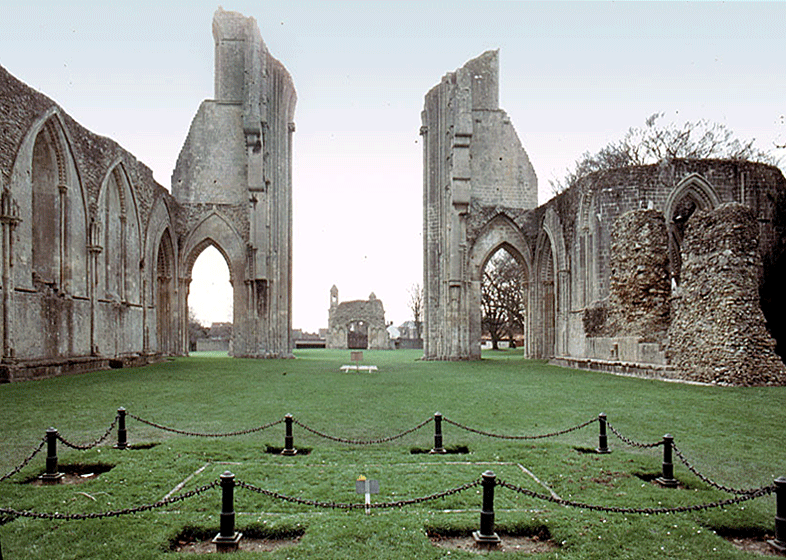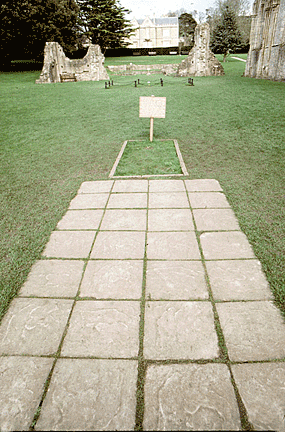|
 The
legends say Morgan Le Fay carried the wounded Arthur off on a barge to the
Isle of Avalon, a Celtic word meaning "the island of apples." Many believe
his final resting place to be in the West Country market town of
Glastonbury. Nestled amidst a small cluster of hills, Glastonbury was almost
an island in early Christian times when much of the surrounding countryside
was a swamp. It's certainly an imposing location, for its highest hill,
Glastonbury Tor, with a solitary tower at its summit, can be seen for miles
around. The
legends say Morgan Le Fay carried the wounded Arthur off on a barge to the
Isle of Avalon, a Celtic word meaning "the island of apples." Many believe
his final resting place to be in the West Country market town of
Glastonbury. Nestled amidst a small cluster of hills, Glastonbury was almost
an island in early Christian times when much of the surrounding countryside
was a swamp. It's certainly an imposing location, for its highest hill,
Glastonbury Tor, with a solitary tower at its summit, can be seen for miles
around.
In 500 A.D, marshes and swamps surrounded Glastonbury Tor. Tradition has it
that the Tor, now often surrounded by mist, was the Isle of Avalon.
Tor is an old West Country word meaning hill. It's difficult to imagine
Glastonbury Tor without its distinctive tower, but until Norman times, when
the monks built a chapel to St. Michael, the hill remained bare. An
earthquake destroyed the chapel in 1275, and it lay in ruins for 50 years
until the Abbot of Glastonbury, Adam Sodbury, rebuilt it. The monks added a
tower, now all that remains, in the 15th century, .
 There
can be few more magical sights than that of Glastonbury Tor on a misty
morning. The flat mist-shrouded plain of Somerset, suddenly interrupted by
the almost pyramid-shaped hill, appears like an island floating mysteriously
in the sunshine. From its summit I could see the dark wooded hilltop of
Cadbury, King Arthur's Camelot. There
can be few more magical sights than that of Glastonbury Tor on a misty
morning. The flat mist-shrouded plain of Somerset, suddenly interrupted by
the almost pyramid-shaped hill, appears like an island floating mysteriously
in the sunshine. From its summit I could see the dark wooded hilltop of
Cadbury, King Arthur's Camelot.
Though the search for Arthur's grave brought me to Glastonbury, once there,
the majesty of the ruins made me want to linger. The Abbey ruins, set among
manicured lawns and imposing trees, are all that remain of one of medieval
England's greatest monasteries. None of the walls left standing is older
than 1184. On May 24 of that year a great fire destroyed the monastery. Many
believe the Abbey was the home of the first Christian community in England.
Evidence shows that monks and hermits may have lived there as early as the
5th and 6th centuries.
Glastonbury's link with King Arthur arose as a result of a discovery said to
have been made in the late 1100s within the grounds of the Abbey. In 1190,
during reconstruction after the fire, the monks claimed to have discovered a
grave. They dug down seven feet before reaching a stone slab, below which
lay a lead cross, bearing the Latin words:
HIC IACET SEPULTUS INCLYTUS REX ARTHURIUS IN INSULA AVALLONIA CUM UXORE SUA
SECUNDA WENNEVERIA. (Here lies the renowned King Arthur in the Isle of
Avalon with his second wife Guinevere.)
The monks dug nine feet further and found a coffin, a hollowed out oak tree
trunk containing the bones of what appeared to be an immensely tall man,
plus some smaller bones and a scrap of yellow hair. He appeared to have ten
wounds, all healed except one.

The discovery of the grave was, to say the least, timely, for the monks were
in desperate need of funds for rebuilding. And the only sure way to raise
money was to attract large numbers of pilgrims.
 Now
a simple sign on the neatly trimmed lawn of the Abbey marks the grave from
which the royal remains disappeared after King Henry VIII ordered the
Abbey's dissolution in 1539. Now
a simple sign on the neatly trimmed lawn of the Abbey marks the grave from
which the royal remains disappeared after King Henry VIII ordered the
Abbey's dissolution in 1539.
Was King Arthur real? Did he exist as a true King? Was he a Celtic hero,
ruler and conqueror or the romantic medieval knight in shining armor?
So many theories have been suggested, so much written about him over the
centuries that even though the truth may have become somewhat distorted,
it's hard to imagine such a person couldn't have existed to spawn all those
tales.
King Arthur and his court continue to fascinate me and countless others,
perhaps because we know so much of the legend and so little of the truth.
So the famous sites traditionally associated with Arthur don't withstand
historical scrutiny. While there's no document to prove Arthur's existence.
Archaeologists have recently discovered a flat stone on which is incised the
name “Arthur.” But there's still not much to say that he did exist. After
all, the legend of King Arthur may just be a myth, Only the ancient Celts
know for sure.
This article
originally appeared in British Heritage Magazine.
<
Back to Special Features
Go to next special feature >
|
